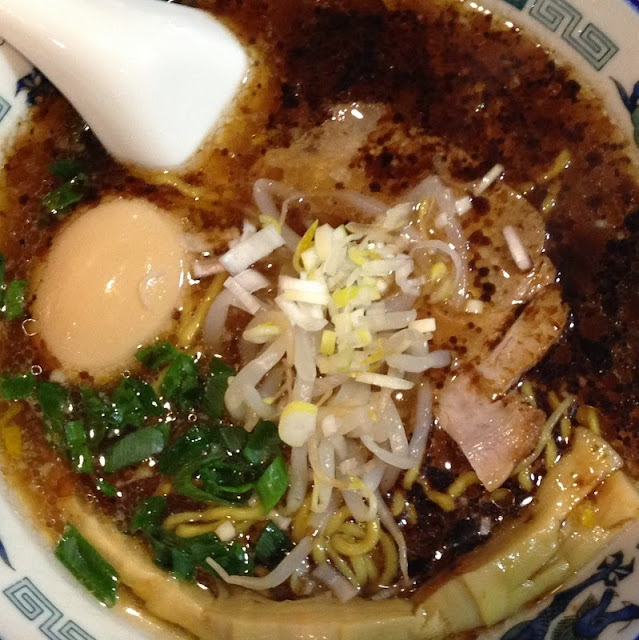銀座 篝
ぎんざ かがり
Ginza Kagari
Niboshi shoyu: 18 / 20
(煮干醤油SOBA)
Tori paitan: 17 / 20
(鶏白湯SOBA)
Kagari… this names sounds like a beginning for me. During my Tokyo stay, nearly one year ago, when I decided to start going to the most mythical ramen of the capital city, Kagari was the first ‘big name’ I tried - and like everyone, I had been impressed by their refined tori paitan. They also serve a niboshi shoyu ramen (also available as a tsukemen) that has been regularly praised, so it was now time to try it.
Broth: No doubt, the niboshi is there, but relatively light compared to some niboshi-bombs like Nagi or Ozeki; the broth gets however more and more of the delicious niboshi-pungency as you finish it.
Noodles: A bit soft.
Meat: A good, slightly sweet, light chashu; and also a slice of red and firm roastbeef, an interesting change.
Toppings: A slice of crunchy lotus. A few bamboo shoots, fresh and slightly acid, a very nice change from the usual menma. As usual, the nori fits extremely well with the niboshi – niboshi is definitely the best broth for nori in my opinion!
A refined, subtle and beautifully crafted bowl. How does the tori paitan fare in comparison?
The broth had a wonderful smoothness and tasted a bit like a high quality mushroom soup, that you can spike with ginger and dry onions. You get a few delicate chicken slices, firm and melting, sprinkled which yuzu zest. The bamboo shoots (fresh, not menma) were good and beautiful. Noodles were a bit soft for my taste here too, although such a cooking style fits better with a tori paitan than with a niboshi broth.
It's a kind of intense experience to altenate one spoon of each broth: extreme smoothness followed by pungent punch, that’s what you call a contrast! Contrarily to many people who blogged on this, my heart lies more on the punchy side and I would elect the niboshi as the real star here, but you should try both by yourself to decide.
Oh and we also ordered the grilled rice ball of rice with mentaiko consomme and fuki miso - not bad, but not a must.
More info on ramendb.
Other reviews: Japan Times, Ramen Adventures, Ramen is love, Tokyo Pig out, Dining without borders, Japan Page, Kylie eats Japan, Go Ramen.
ぎんざ かがり
Ginza Kagari
Niboshi shoyu: 18 / 20
(煮干醤油SOBA)
Tori paitan: 17 / 20
(鶏白湯SOBA)
Kagari… this names sounds like a beginning for me. During my Tokyo stay, nearly one year ago, when I decided to start going to the most mythical ramen of the capital city, Kagari was the first ‘big name’ I tried - and like everyone, I had been impressed by their refined tori paitan. They also serve a niboshi shoyu ramen (also available as a tsukemen) that has been regularly praised, so it was now time to try it.
Broth: No doubt, the niboshi is there, but relatively light compared to some niboshi-bombs like Nagi or Ozeki; the broth gets however more and more of the delicious niboshi-pungency as you finish it.
Noodles: A bit soft.
Meat: A good, slightly sweet, light chashu; and also a slice of red and firm roastbeef, an interesting change.
Toppings: A slice of crunchy lotus. A few bamboo shoots, fresh and slightly acid, a very nice change from the usual menma. As usual, the nori fits extremely well with the niboshi – niboshi is definitely the best broth for nori in my opinion!
A refined, subtle and beautifully crafted bowl. How does the tori paitan fare in comparison?
The broth had a wonderful smoothness and tasted a bit like a high quality mushroom soup, that you can spike with ginger and dry onions. You get a few delicate chicken slices, firm and melting, sprinkled which yuzu zest. The bamboo shoots (fresh, not menma) were good and beautiful. Noodles were a bit soft for my taste here too, although such a cooking style fits better with a tori paitan than with a niboshi broth.
It's a kind of intense experience to altenate one spoon of each broth: extreme smoothness followed by pungent punch, that’s what you call a contrast! Contrarily to many people who blogged on this, my heart lies more on the punchy side and I would elect the niboshi as the real star here, but you should try both by yourself to decide.
Oh and we also ordered the grilled rice ball of rice with mentaiko consomme and fuki miso - not bad, but not a must.
More info on ramendb.
Other reviews: Japan Times, Ramen Adventures, Ramen is love, Tokyo Pig out, Dining without borders, Japan Page, Kylie eats Japan, Go Ramen.






























